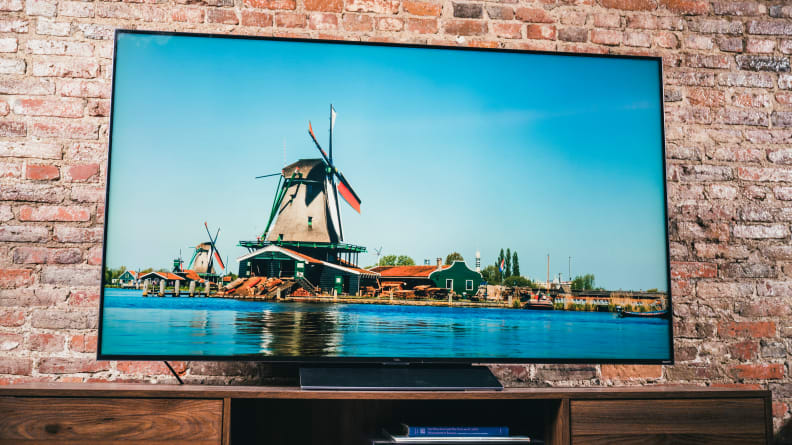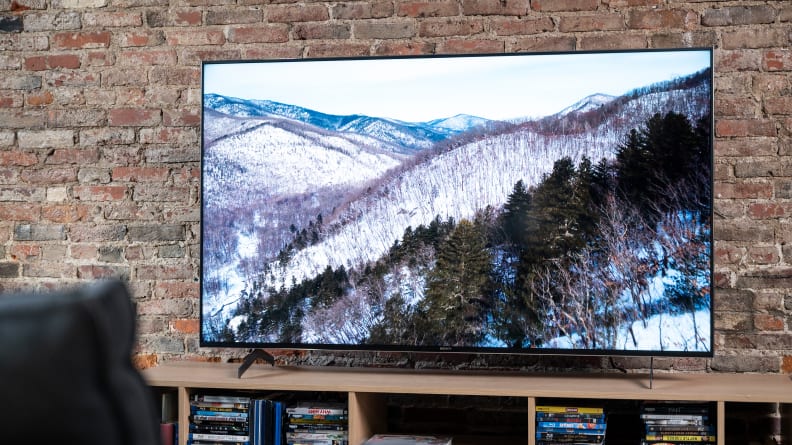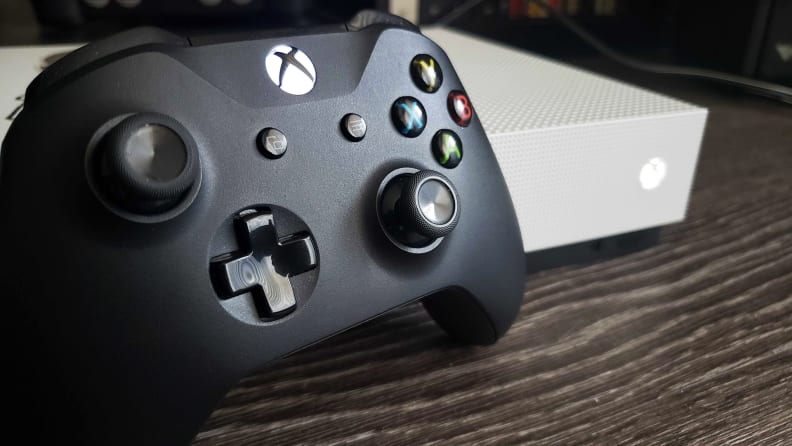What is refresh rate and why does it matter for TVs?
Motion looks different depending on the TV—here's why
 Credit: Reviewed / Betsey Goldwasser
Credit: Reviewed / Betsey Goldwasser
Recommendations are independently chosen by Reviewed’s editors. Purchases you make through our links may earn us a commission.
It used to be that shopping for a new TV was a matter ofTV brand和screen size. These days, there’s way more to consider, like the不同类型的显示技术,HDRsupport, andsmart features.
您肯定会在每个电视盒上看到的一个标签是refresh rate. It’s a hardware specification that describes how motion is handled on any given TV. Before you buy your next TV, it’s worth taking this spec into consideration—particularly if you’re an avid gamer or sports fan who watches a lot of fast-paced action. Below we'll help dispel the mysteries of this technology to help you make the right decision for your household.
What is refresh rate?

Refresh rate—measured in hertz (Hz)—describes the amount of times the picture refreshes per second.
To put it in the simplest terms, a display’s refresh rate describes the number of times per second the display resets the image, whether you’reshopping for a TVor acomputer monitor. The refresh rate is measured in Hz.
从本质上讲,显示器的刷新率越高,在屏幕上显示的每个视频框架之间的时间就越少。较高的刷新率意味着电视或显示器可以每秒显示更多帧(FPS),这取决于所用的内容,可能会影响视频外观的光滑和令人愉悦。在下面,我们将更深入地了解这对您以及您所观看的内容。
What is a good refresh rate for a TV?
There are essentially two types of common refresh rates available when it comes to contemporary TVs: 60Hz and 120Hz. Generally, 60Hz TVs are more affordable than 120Hz TVs because the 120Hz spec is usually found on TVs that offer premium hardware and software features in addition to higher-quality motion handling.
在2022年,TCL和Samsung同时宣布与一个144 hz本地电视刷新老鼠e for release this year, but more information has yet to come to light, including model names, prices, and release dates. This spec has been available in some computer monitors for years, and in fact, some monitors offer native refresh rates that go much higher, up to 360Hz.
As far as TVs go, however, most people will end up choosing between 60Hz and 120Hz right now.
What’s the difference between refresh rate and frame rate?

Frame rate describes the amount of frames per second being displayed at any given time. Most filmic content is shot at 24fps.
While the refresh rate describes the number of frames of video per second a particular TV or monitor is capable of displaying, the frame rate describes the playback speed (in seconds) of a piece of video content. The frame rate of a piece of video content will be listed in fps (frames per second). Let's look at how that may apply to your experience.
For example, broadcast television in the U.S. plays at a standard 30fps (actually just below this at 29.97fps), which fits nicely into a 60Hz TV's refresh rate. However, most movies are shot at 24 frames per second (fps), which was settled upon in the early days of film. This is the frame rate you'll likely see when you pop in a Blu-ray disc or a film on streaming service. If you settle in to watch a movie on Netflix, you're probably watching something at 24fps.
The problem is, the average 60Hz TV can't render native 24fps content without a little bit of help, since every three seconds the TV gets out of sync. To combat this, many modern 60Hz TVs use a telecine technique called 3:2 pulldown, where frames are doubled in alternating sequences in order to "meet up" with the display's 60Hz refresh rate. Unfortunately, 3:2 pulldown usually results in a motion artifact called judder, where some sequences during playback can have a stuttering or skipping effect.
While many modern 60Hz TVs do 3:2 pulldown so successfully that you probably won't notice the amount of judder in most scenarios, you can save yourself any trouble by purchasing a 120Hz TV. That's because 24fps divides evenly (5 times) into a 120Hz refresh rate.
In addition, if you've recently bought a next-gen gaming console, you're likely going to be displaying content at much higher frame rates than film or broadcast TV. This is where having a TV with a higher refresh rate can really pay off.
What are the advantages of a high refresh rate?

The 120Hz spec ensures that you’ll be able to play console games that offer 120fps game modes.
One advantage of a120Hz TVcenters around the gaming benefits touched on above. In addition to being inherently better at handling fast-paced video games, the 120Hz spec also ensures that you’ll be able to play console games that offer 120fps game modes to perfectly sync up with the ultra-fast motion and get the best out of your gaming experience.
目前,Xbox Series X和thePlayStation 5are all capable of displaying 4K games at 120fps, and while there aren’t very many games yet that hit this benchmark, you can expect to see more of them in the coming years. If you're a PC gamers who wants to play on the big screen, you'll also reap the benefits from a 120Hz TV, as high frame-rate games have been available in that ecosystem for quite some time.
If you own one of these consoles butdon’town a TV with a native 120Hz refresh rate, you won’t have the best possible gaming experience at your fingertips. That's not to mention other gaming advantages that often come with premium TVs, likeVariable Refresh Rate (VRR) and Auto Low Latency Mode (ALLM).
Regardless of frame rate, higher refresh rates tend to eliminate blur from fast motion, which isn’t just valuable for gaming: It also matters during high-action content, like sports. Because 120Hz TVs check for new information twice as often as 60Hz TVs, they can sometimes render particular sequences in sports with more clarity.
Should I buy a 120Hz (or higher) TV?
Ultimately, you might care more about landing a great deal on an affordable TV than you do about achieving the ultimate gaming or film experience. If you’re more of a casual viewer and sports broadcasts aren’t incredibly important to you and your family, there are plenty ofbudget-friendly 60Hz TVsthat will fit your lifestyle perfectly.
That said, we highly recommend shopping for a 120Hz TV if you’re an avid gamer, a dedicated sports fan, or if you just want your movies and shows to look as easy on the eyes as possible. Motion handling can have a big impact on picture quality, especially for those specific content types.
All of the options in our round-up ofthe best gaming TVsfeature a native refresh rate of 120Hz, and several of the picks in our round-up ofthe best TVsdo, as well.
The product experts atReviewedhave all your shopping needs covered. Follow Reviewed onFacebook,Twitter,Instagram,TikTok, orFlipboardfor the latest deals, product reviews, and more.
Prices were accurate at the time this article was published but may change over time.






